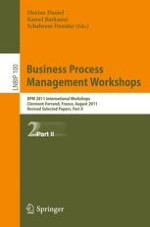LNBIP 99 and LNBIP 100 together constitute the thoroughly refereed proceedings of 12 international workshops held in Clermont-Ferrand, France, in conjunction with the 9th International Conference on Business Process Management, BPM 2011, in August 2011. The 12 workshops focused on Business Process Design (BPD 2011), Business Process Intelligence (BPI 2011), Business Process Management and Social Software (BPMS2 2011), Cross-Enterprise Collaboration (CEC 2011), Empirical Research in Business Process Management (ER-BPM 2011), Event-Driven Business Process Management (edBPM 2011), Process Model Collections (PMC 2011), Process-Aware Logistics Systems (PALS 2011), Process-Oriented Systems in Healthcare (ProHealth 2011), Reuse in Business Process Management (rBPM 2011), Traceability and Compliance of Semi-Structured Processes (TC4SP 2011), and Workflow Security Audit and Certification (WfSAC 2011). In addition, the proceedings also include the Process Mining Manifesto (as an Open Access Paper), which has been jointly developed by more than 70 scientists, consultants, software vendors, and end-users. LNBIP 100 contains the revised and extended papers from PMC 2011, PALS 2011, ProHealth 2011, rBPM 2011, TC4SP 2011, and WfSAC 2011.
